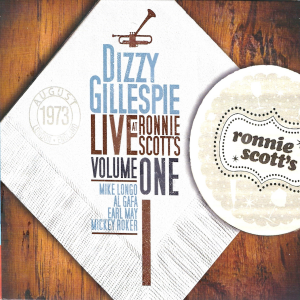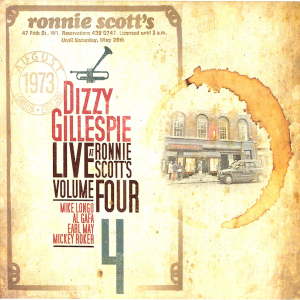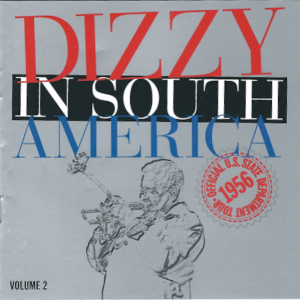Dizzy Gillespie in South America Vol 3
$9.97
Yesterdays; Night In Tunisia; Cepao’s Samba; Gloria Samba; Adios Muchachos; Preludio no. 3; Capriccio de Amor; Vida Mia; Dizzy Introduction; Dizzy Interview; Jones Introduction; Quincy Jones Interview; Woods Introduction; Phil Woods Interview, Billy Mitchell, Charlie Persip, Boo Fraier Interview: Bennie Golson, Rod Levitt Interview, Lalo Schifrin Interview
The third of 3 Volumes of Previously Never Released Dizzy Gillespie. Already In the line up of nominations for The Grammy’s “The best historical recording” for 2001. In 1956, Dizzy was asked by the State Department to assemble a big band to tour South America.
These recordings were done live throughout the tour with great success. These recordings represent a pinnacle in Dizzy Gillespies’ remarkable career as Band Leader and Trumpet Icon.
The added feature of this cd set is the extended interviews by members of the band as well as well as other notable constituents of Dizzy.
– Ira Gitler
Dizzy Gillespie:
Leader and Trumpet
Quincy Jones, Bama Warwick, and E.V. Perry: Trumpet
Phil Woods and Jimmy Powell: Alto Sax
Benny Golson, Billy Mitchell: Tenor Sax
Marty Flax: Baritone Sax
Melba Liston, Frank Rehak, and Rod Levitt: Trombone
Austin Cromer: Vocals
Walter Davis Jr.:Piano
Nelson Boyd: Bass
Charlie Persip: Drums
About “Dizzy Gillespie In South America Vol 3”
If you don’t know the music on this 3 CD set, you should, as you will find it to be some of the fullest expressions of Dizzy’s mature style ever captured on record, as well as,
a record of the beginning steps of instrumentalists such as Phil Woods, Benny Golson, and Charlie Persip that would help them develop into full-fledged Jazz icons during the later years of their careers.
The interviews included on this, the third disc in the set, are priceless primary sources.
And the band, feeding off of the enthusiasm and energy of the audience, never sounded more exhilarating. Charlie Persip’s big band drumming is a revelation.
Dizzy’s solo on Night in Tunisia is one of his most spectacular on record IMHO.
“In the course of an interview with Dan Morgenstern, many years ago, Dizzy Gillespie stated: “I’m a rhythm man, you know. I used to play for dancers,” and added, talking about his wife,
Lorraine, “She used to be a dancer, and I still try to phrase like that. I loved to play for the chorus line at the Cotton Club. One night — I had just joined Teddy Hill – I was playing something that really made that line step, and Bill Robinson was watching in the wings. He turned around to somebody and asked. ‘Where did that little bastard come from?’ I’m still a rhythm man.”
Given his predilection for rhythm, it is not surprising that Gillespie became involved, early on, with Latin beats and notes.
In cosmopolitan New York he was first exposed to the world as a member of the Teddy Hill orchestra, in 1937. The Latin Beat was in the air.
In 1938 he appeared at the Savoy Ballroom with the eminent Cuban flautist Alberto Socarras. “I wanted my band to play everything,” said Socarras, “”Spanish music, Brazilian music, Argentine music, Cuban and American music. But I wanted my music to sound American. So when the trumpet solos came, Dizzy took over. It sounded American because an American was playing it. It was easy for Diz to go from American music to Cuban music, see. Also, I wrote my own arrangements, and Dizzy s solos were very nice, very Cuban-like.’
“We played Cuban music first, like boleros and things like that, and he phrased his solos marvelously. Then we played rhumbas, fast numbers, and his style was very Cuban. To him, it was as easy as American music was to me.”
When Gillespie joined Cab Calloway’s band in 1939, his section mate and roommate was Cuban Mario Bauza, who had taken a day off so that Dizzy could replace him and thereby directly audition for Cab. “Mario was the first to impress me with the importance of Afro-Cuban music,” Diz stated. He became interested in its various aspects and told Bauza that if he ever led his own band, he would incorporate a conga drum. A man of his word, Diz did just that in the 1947 edition of his big band when he hired the great Chano Pozo. Recordings such as “Algo Bueno,” “Manteca” and “Cubano Be-Cubano Bop” were instrumental in establishing Afro-Cuban as a powerfully viable jazz expression.
His State Department trip to South America in 1956 gave the ever-inquisitive Gillespie a firsthand opportunity to encounter indigenous forms such as the tango and samba. After playing in Ecuador, the band arrived in Buenos Aires via a non-playing stopover in Chile.
In Buenos Aires Osvaldo Fresedo, the tango king had a nightclub where his band appeared. Usher, who had been invited by Dizzy to record the big band but who also served unofficially as press liaison, tells the extraordinary story of the event. “Fresedo did an impromptu recording with his orchestra and Dizzy. Before that, for publicity purposes, I went to the opera house and got Dizzy a gaucho costume. So Diz had the hat. the lace shirt, a vest and a big belt. Actually. Che Guevara’s sister gave Dizzy and me a belt. Dizzy was also wearing boots with spurs, so we just had to get him a horse. I went to a stable near the racetrack. The horse was swaybacked.”
All of the above applies to Gillespie’s solo on “A Night in Tunisia.” This is not to say that there is anything shabby about Dizzy’s solo on Volume I’s “Tunisia,” but that one is more laid back — for Diz. This solo is of “jaw-dropping” dimensions. While my mandible was descending to the floor, the rest of my head was shaking itself in awe. I had to play it again before moving on to Benny Golson s tenor saxophone solo. The thrust of Benny’s inspired improvisations are further proof of Phil’s adage that “you had to take care of biz.” Bassist Nelson Boyd s solo changes the pace before Charlie Persip drums the shouting ensemble back onto the bridge. Frank Rehak’s trombone, in his instrument’s traditional role on Gillespie’s anthem, plays the last eight bars of the theme, and then it’s Diz’s coda.’Nuff said.
The spoken documentation of the tour originally consisted of three interview sessions. The first was conducted with Gillespie at the Continental Hotel in Buenos Aires, and you are aware of the Spanish translator in the background. Dizzy gives a history lesson and dispenses some nuggets from his deep well of wisdom. His reference to the elements necessary for the music to be truly considered jazz are equally applicable today — even more so.
The other two discussions were brought about by Dave Usher, who felt it was important to reunite some of the surviving members of the South American tour to share their remembrances. In 2000 he participated in one meeting with tenor saxophonist Billy Mitchell (who, sad to say, passed away on April 18,2001), Charlie Persip and deejay Boo Frazier (Dizzy’s cousin who served as an aide de camp on the tour) and another meeting with Benny Golson and trombonist Rod Levitt.
These tapings, quite naturally, contain many stories about the Gillespie band and the entire South American experience, but they go beyond that. The first includes tales of the Basie band, Dinah Washington, Lester Young and others, and the second contains references to Astor Piazzolla, Heitor Villa-Lobos and Lalo Schifrin.
In 2001 Usher taped three more interviews, with Quincy Jones, Phil Woods, and Lalo Schifrin. Some of the same topics and people are discussed from other angles with ardor and insight; there are revelations about the effect of Dizzy’s tour on Jobim and Gilberto, and further testimony is offered on the widespread influence of Gillespie on the music of the 20th century. It is better listened to than described. Listen!
DIZZY IN SOUTH AMERICA Volume 3 is a unique combination of music and talk. Together with the preceding volumes, it gives a vivid account of an important chapter in the life of one of the greatest musicians the world has ever seen and heard.”
—Ira Gitler






